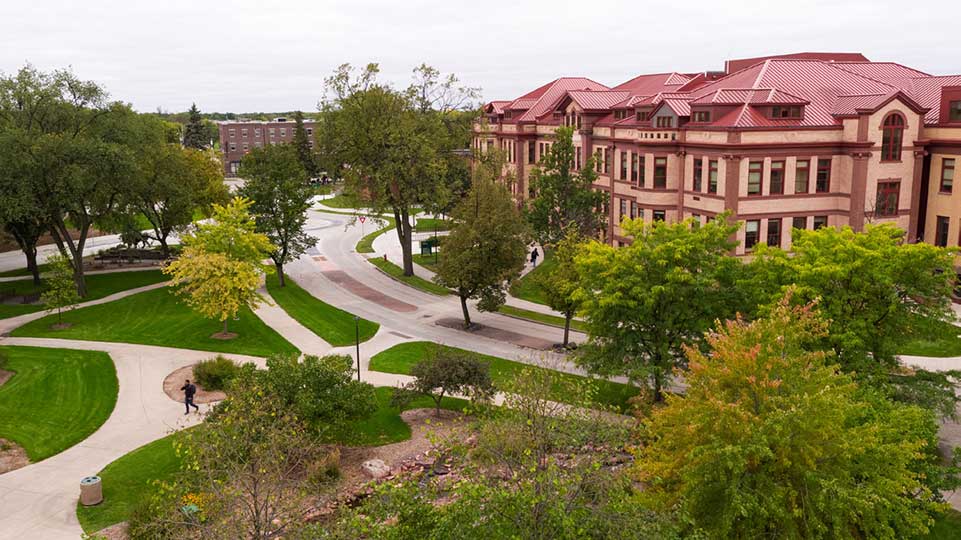
Photo courtesy NDSU
Article courtesy of Lucy Wyndham
UNDATED (NewsDakota.com) – Total postsecondary enrollment (including undergraduate and graduate students) decreased by 4.1% in spring 2022 compared to spring 2021, according to one report by the National Student Clearinghouse Research Center (NSCRC).
With the past couple of years having had a dramatic impact on the higher education industry, online learning methods may just be the silver lining. From understanding the current academic climate to how the accessibility of online learning has the potential to help students in a variety of ways, here’s what you need to know.
The current academic climate
More than one million fewer students are enrolled in college now than before the pandemic began, notes NPR. In fact, U.S. colleges and universities saw a drop of nearly 500,000 undergraduate students in the fall of 2021, according to data, and many have left due to a variety of factors. In addition to the pandemic itself, other reasons for low college enrollments include the cost of attendance, and many are taking the time to prioritize work over studying.
The low enrollment trend isn’t new in North Dakota, either, though there is hope — after several years of declining enrollment, North Dakota State University saw a welcome increase in applications, according to one InForum article published in December 2021. The article notes that NDSU received 7,189 first-year applications for the 2022-21 school year (as of December 10th, 2021), highlighting an increase from previous years. “Apps do not equal enrolled students, but it is certainly a good sign that people are finding our academic programs and student experience to be appealing,” notes Laura Oster-Aaland, vice provost for student affairs and enrollment management tells InForum.
A preference for online learning
While NDSU’s increase in applications shows promise, attracting and retaining students is an important aspect for institutions of higher education across the country. According to one Digital Learning Pulse survey, 73% of students either “somewhat” or “strongly” agreed that they would like to take some fully online courses in the future, while 68% said that they would be interested in taking courses that offered a hybrid of online and in-person instruction.
The survey, which included responses from 772 teaching faculty, 514 academic administrators and 1,413 students who were registered at a U.S. higher education institution for both the fall 2020 and spring 2021 semesters highlights how online higher education is viewed on a nationwide scale. To further underline the popularity of online learning, onlineu.com notes that 62%, or nearly 40,000 of North Dakota’s university students are pursuing their degrees online.
In addition to being a more cost effective and flexible option for students in general, those who have an introverted personality may reap further benefits from online courses. Due to the oftentimes demanding social environment that comes along with the traditional college experience, many introverts may be left feeling overwhelmed or even uncomfortable at times. However, as digital learning rises in popularity, universities can support and enable introverts by offering online or hybrid courses. For those who need varied learning and the opportunity to engage in their studies in a quiet environment, a digital learning environment can help create an academic atmosphere that will allow introverts to thrive.
Addressing the teacher shortage
While online learning options can be a great thing for North Dakota’s university students across the board, it may also aid in combating current teacher workforce shortages throughout the state, too. At its meeting at UND’s Memorial Union on Thursday, September 8th, The North Dakota Legislature Interim Higher Education Committee advanced a bill that would provide funding to the Teacher Shortage Grants. According to the Grand Forks Herald, The Teacher Shortage Grants is a North Dakota Department of Public Instruction (NDDPI) program which “provides funding to paraprofessionals to return to school online for teaching degrees.”
The article further goes on to explain the teacher shortage, noting that across the state, K-12 schools have 418 open teaching positions. “There are students out there who are interested in going into the teaching profession, however, it is somewhat daunting to think about going to school for four years, racking up student debt and then looking at paying that off on a teacher’s salary,” Laurie Matzke, assistant superintendent at the NDDPI tells the Grand Forks Herald.
The coronavirus pandemic, high costs of enrollment, and other issues have presented challenges for students and educational institutions alike. When looking for a solution, embracing online learning methods can make higher education more accessible for many — and may even aid in addressing issues such as teacher shortages.
